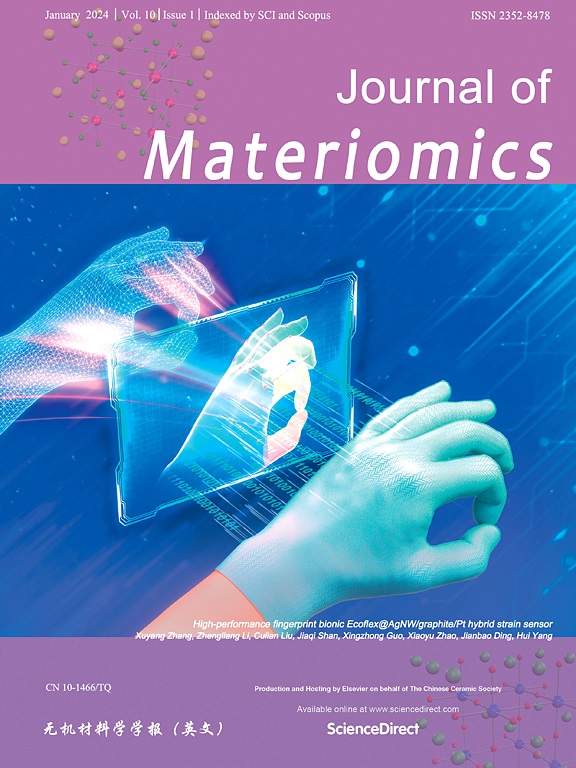Ultrahigh energy storage performance via defect engineering in Sr0.7Bi0.2TiO3 lead-free relaxor ferroelectrics
IF 9.6
1区 材料科学
Q1 CHEMISTRY, PHYSICAL
引用次数: 0
Abstract
With the development of advanced electronic memory and the advocacy of environmental friendliness, lead-free relaxor ferroelectric capacitors with slim hysteresis loops have received great attention in high power energy storage applications. However, various emerging defects in Sr0.7Bi0.2TiO3 based relaxor ferroelectric films can result in inferior energy storage performance. In this work, Mn doping is utilized to modify the defects caused by the excessive Bi compensation in the Sr0.7Bi0.2TiO3 relaxor ferroelectric thin films. Those Mn doped Sr0.7Bi0.2TiO3 thin films exhibits significantly improved recoverable energy storage density by more than one order of magnitude with an ultrahigh energy storage density (126 J/cm3). By analyzing the change of the chemical environment and using the scanning transmission electron microscopy, we reveal these improved energy storage performances arises from the formation of defect dipoles of Mn2+ at B site with oxygen vacancies, suppressing the volume of oxygen vacancies and titanium vacancies simultaneously, and the slush-like “single domain” structure with fluctuated B-site cation displacements stabilized and confined in a single nano-sized crystal grain. This chemical modification strategy in this work can serve as a regular approach to suppress the defects and improve the energy storage performance in ferroelectric thin films with volatile elements.


通过 Sr0.7Bi0.2TiO3 无铅弛豫铁电体中的缺陷工程实现超高储能性能
随着先进电子存储技术的发展和对环境友好的倡导,具有细磁滞回线的无铅弛豫铁电电容器在大功率储能领域的应用受到了广泛的关注。然而,Sr0.7Bi0.2TiO3基弛豫铁电薄膜中出现的各种缺陷导致其储能性能较差。本文采用Mn掺杂的方法对Sr0.7Bi0.2TiO3弛豫铁电薄膜中由于Bi补偿过多而产生的缺陷进行了修正。Mn掺杂的Sr0.7Bi0.2TiO3薄膜的可回收储能密度显著提高了一个数量级以上,达到了126 J/cm3的超高储能密度。通过对化学环境变化的分析和扫描透射电镜的分析,我们发现这些储能性能的提高是由于Mn2+在具有氧空位的B位形成缺陷偶极子,同时抑制了氧空位和钛空位的体积,并且具有波动的B位阳离子位移的泥状“单畴”结构稳定并被限制在单个纳米晶粒中。本研究的化学改性策略可作为抑制含挥发性元素铁电薄膜缺陷和提高其储能性能的常规方法。
本文章由计算机程序翻译,如有差异,请以英文原文为准。
求助全文
约1分钟内获得全文
求助全文
来源期刊

Journal of Materiomics
Materials Science-Metals and Alloys
CiteScore
14.30
自引率
6.40%
发文量
331
审稿时长
37 days
期刊介绍:
The Journal of Materiomics is a peer-reviewed open-access journal that aims to serve as a forum for the continuous dissemination of research within the field of materials science. It particularly emphasizes systematic studies on the relationships between composition, processing, structure, property, and performance of advanced materials. The journal is supported by the Chinese Ceramic Society and is indexed in SCIE and Scopus. It is commonly referred to as J Materiomics.
 求助内容:
求助内容: 应助结果提醒方式:
应助结果提醒方式:


